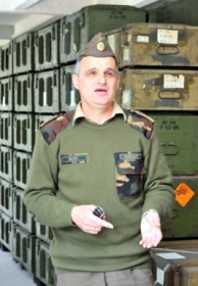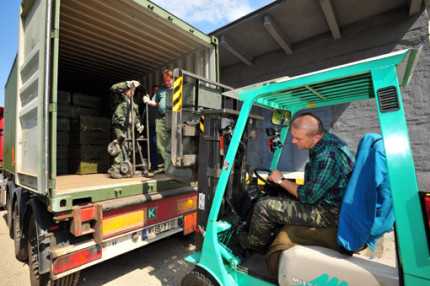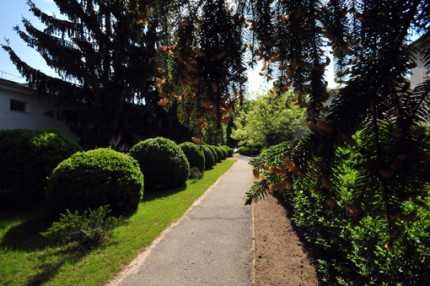The ‘Real’ Centre of the Country
Szöveg: László Szűcs | 2008. május 7. 13:28The ‘Real’ Centre of the Country Although the Hazardous Material Supply Centre of the Hungarian Defence Forces (MH VEK) ‘hides’ relatively far, some 5-6 kilometres from inhabitated settlements, for the employees the spectacular surroundings of the barracks are a compensation. Maps simply call this area covered with oaks and beech trees the Pusztavacs forest, where even the air ‘tastes’ better.
Upon entering the barracks the ‘soldierly’ order strikes the eye of even a lay observer. The shrubs are neatly trimmed, the hedges are carefully cut to identical, almost perfect balls, and the air is full of the pleasant smell of freshly mown grass. And there are various twitters and chirps coming from all around …
“Extremely meticulous" – describes himself Colonel Tibor Bozó, the commander of MH VEK, also adding that he only feels good in the office if he is among the bric-a-bracs he’s collected over the years. On the walls the memorabilia of his military career are on display – certificates, decrees and photographs, and on the shelves of the brown cabinet there are a few smaller presents – among others, a hand-woven miniature Turkish carpet and a special British badge.

“In order to understand the tasks of the Centre, we have to interpret the meaning of ‘hazardous material’ first. In the military terminology this phrase is used for ammunition, rockets, technical military materials – namely various explosives –, aviation pyrotechnical equipment, fuels, and lubricants" – explains the commander, then he moves on to the priority task of MH VEK, which is the registration and storage of these materials for the HDF, and the provision of supply for the troops.
The organization working under the command of HDF Joint Forces Command has the legal status of a regiment; it is active in five garrisons at the moment, providing employment opportunity for nearly 550 people. The majority of the positions on the ’employee list’ are civil servant jobs, due to the special storage/warehousing tasks.
“The headquarters of the Centre are located near Pusztavacs, a small settlement in the Great Plain, with a mere 1,400 inhabitants" – as Colonel Bozó tells me while we take a walk around his ’empire’. I also learn that military material warehouse No1 (HAR) operates in Pusztavacs, as well, under the command of MH VEK. Primarily infantry and artillery ammunition is stored at this base.
“The barracks are the largest employers in the village and in the nearby settlements" – says Colonel Tibor Bozó, who also shares one of the most important classified military information of the 80s’ with us: theoretically, every primary school pupil learns in Geography that the geographic centre of Hungary is at Pusztavacs, as it is symbolized by a memorial on the village boundary. But only a few people know that the tent-shaped structure is in fact some 3,200 metres away from the real centre of the country, for that is located within the fences of the barracks, close to one of the warehouse buildings, in a wooded area. Today there are only trees and shrubs in this spot but Colonel Bozó would like to have a small monument constructed over the famous place in the near future.

In the Pusztavacs military material warehouse different types of ammunition are stored in 29 buildings – tells me Captain László Garaczi, the deputy commander of HAR No1. Most of the 200/500/1,000 sqm warehouses located in the wooded, shrubby surroundings maintained by the forest management of the Ministry of Defence were built in the early 50s, therefore they had to be renovated a few years ago. The situation was the same with an open air storage facility which is still in use – although ‘live’ military materials are no longer stored in this facility, it is only for the collection of empty shells and ammunition boxes returned by the corps.
In addition to the aforementioned, Colonel Tibor Bozó mentions two more interesting activities of MH VEK Pusztavacs Centre: on the one hand, the central test laboratory of the Hungarian Defence Forces operates here, controlling the quality and checking the usability of military materials and fuels. Another special feature of the Centre is a business venture manufacturing decorative objects from ammunition shells. This branch gets more and more successful, since there is a growing demand for copper trinkets.

At the end of our walk we return to the commander’s office and engage in a conversation about the other garrisons within the Supply Centre. Military material warehouse No2 is also nearby, in Táborfalva, with two facilities for the safeguarding of rockets regulary used by the HDF, but there are some other types of ammunition, too, in the warehouses of Táborfalva. As regards infrastructure, this warehouse base is the most up-to-date, with one of the facilities built in the 70s-80s and direct sidetracks from the Budapest–Kecskemét main railway line to the inner areas of the barracks.
Military material warehouse No3 of Kál has railway transport facilities, as well, but the buildings here – similarly to the ones at the Pusztavacs barracks – were constructed in the 50s, therefore the garrison near the town of Eger cannot be considered modern barracks – says Colonel Tibor Bozó. The situation is similar in the warehouse for unused equipment at Hajdúsámson, a settlement in the vicinity of Debrecen. The hazardous materials withdrawn from the system of the Hungarian Defence Forces are stored here until annihilation or sale. We are talking about considerable quantities, with 6,000 tons of unused equipment kept in Hajdúsámson only, and the warehouses of Pusztavacs, Táborfalva, and Kál also stock military materials withdrawn from the system.

The most modern facility of MH VEK is the Hetényegyháza fuel depot – renovated in 2003 –, where in addition to diesel oil and petrol for land combat and motorized vehicles, fuels for fixed wing aircrafts and rotorcrafts are stored. The necessary lubricants are kept here, as well, in the warehouse facility near Kecskemét (or as Colonel Bozó puts it, in the ‘garden city of Kecskemét’). It is quite obvious that environmental protection is a priority issue for this garrison and employees pay special attention to it. For instance various fuels are transferred to underground tanks without contacting air, thus they do not harm the environment in any way.
Following the introduction of the garrisons we talk about the most important tasks of MH VEK in the previous year with Colonel Bozó. I soon learn that the activities that were concomitant of the armed forces reform were dominating in the first half of 2007. Another key issue that was solved last year was the switch from kilograms to litres, as the unit of fuel accounts.